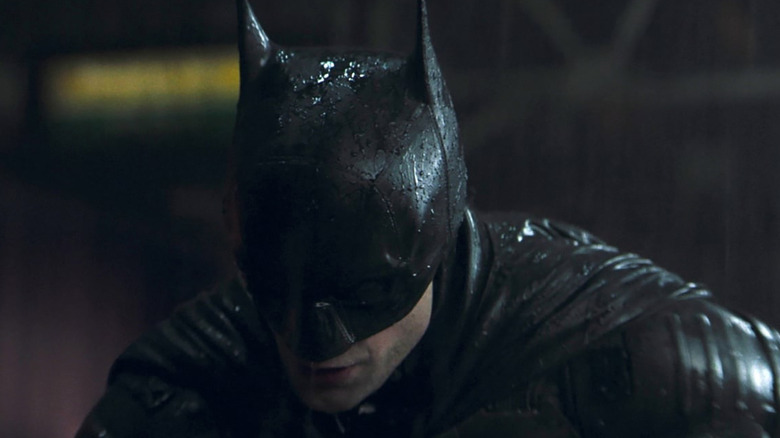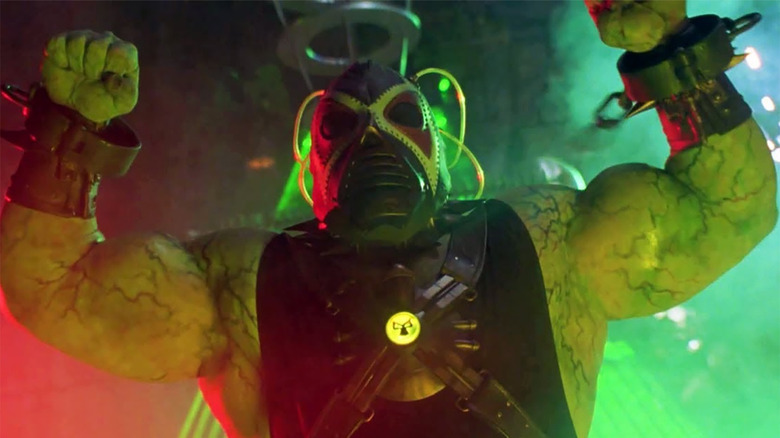The Art Of The Batman Book Debunks The Internet's Venom Shot Theory
During the climax of "The Batman" — now available to stream on HBO Max — The Riddler (Paul Dano) has finally gotten the drop on The Batman (Robert Pattinson). The villain's scheme involves an elaborate plan to flood Gotham City, herd a group of high-profile survivors into a slowly-filling indoor stadium, and use a large group of acolytes — all dressed in matching Riddler costumes and armed with rifles — to open fire into the crowd. Acting fast, Batman infiltrates the catwalks and perches where the imitation Riddlers are poised and begins dispatching them one by one. Some, he disarms and suspends from cables. Others he merely knocks out. As one might imagine, this is exhausting work for Batman. During this climactic fight, Batman is knocked down, and teeters on the brink of unconsciousness. With his final ounce of strength, Batman reaches into his utility belt and extracts a vial of bright green liquid. He injects himself with the liquid and is suddenly back on his feet, now crazed with energy, eager to crush more faces with his fists.
There is no dialogue to explain what the green liquid was, exactly. It certainly contained some sort of adrenaline-boosting compound, but with no explicit description on camera, Batman fans began postulating what sort of connections that needle had to extant Batman lore. The dominant theory was that the needle contained Venom. No, not the alien black goop monster that lives inside of Tom Hardy in the movie "Venom," but a fictional ultra-powerful steroid established in Batman comic books as the muscle-growing compound used by the supervillain Bane.
The book "The Art of the Batman" by James Field (available now) contains a detailed concept drawing of the needle prop Pattinson used on the set. In the drawing, it's made explicit that Batman did not inject himself with Venom, but run-of-the-mill epinephrine, an adrenal hormone that is often used to regulate breathing, but can also cause a spike in adrenaline, giving one a burst of energy. Adrenaline shots have previously been showcased in films like "Pulp Fiction," "The Rock," and "Teenage Mutant Ninja Turtles."
Venom
Venom, the steroid, was injected into a small, spindly criminal at the start of the 1997 film "Batman & Robin," causing the criminal to expand into the muscled monster Bane. That take on the character was a far cry from his comic book equivalent, a regular in Batman's rogue's gallery of villains, who often uses enormous quantities of Venom to make himself into a five-foot-wide monstrosity. The version of Bane seen in 2012's "The Dark Knight Rises," where he was played by Tom Hardy, was never seen using the fictional drug. In short: fans may have jumped the gun because the idea of Bane finally being done right on the big screen is enticing.
As clearly seen in the image from the book, the vial in Batman's epi-pen is not Venom, but epinephrine. Jamie Wilkinson, the prop master on "The Batman" (and who has served as the property master on multiple blockbusters besides) also say as much:
"In emergencies, if he himself of somebody might need an adrenaline shot in a situation, this would be pumped in, and a shot of adrenaline straight into the system."
Apologies to fan theorists who saw the appearance of Venom as a hint that this particular version of Batman would immediately get into a fistfight with his equivalent version of Bane. This theory has been officially debunked by an extra-canonical, expanded universe text. Instead, let us focus on how Pattinson's version of Batman will handle Bat Mite.

